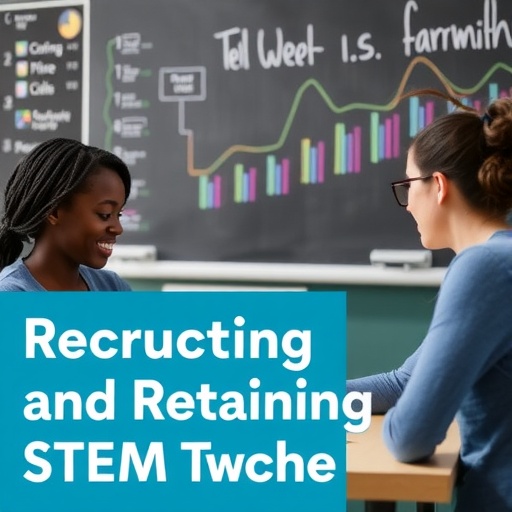In the rapidly evolving landscapes of science, technology, engineering, and mathematics (STEM), the critical issue of cultivating a robust and sustainable teaching workforce has never been more urgent. Researchers Thompson-Lee, See, and Klassen have undertaken a systematic review that comprehensively examines current interventions aimed at recruiting and retaining STEM educators. Published in the International Journal of STEM Education in 2025, their rigorous meta-analysis illuminates the multifaceted challenges and promising strategies shaping the future of STEM education worldwide.
As global economies increasingly pivot towards innovation-driven models, the demand for skilled STEM professionals escalates, amplifying the pressure on educational systems to produce competent students. However, this demand exposes glaring shortages in qualified STEM teachers—a gap that threatens the pipeline of future innovators. The systematic review meticulously maps out existing recruitment initiatives, highlighting how targeted policies and incentive structures serve as pivotal levers in attracting capable candidates to STEM teaching roles.
One of the dominant themes emerging from the review is the nuanced relationship between teacher identity and retention rates. Retention interventions extend beyond mere financial rewards, delving into professional development opportunities, mentoring programs, and school culture improvements. The authors argue that fostering a sense of belonging and professional efficacy among STEM teachers is paramount to long-term commitment. Such psychosocial factors often outweigh classic monetary incentives, signaling a paradigm shift in how educational stakeholders approach teacher sustainability.
The study also underscores the variability across regions in addressing STEM teacher shortages, revealing how socioeconomic contexts and policy frameworks shape recruitment outcomes. In highly developed regions, where STEM fields are competitive and well-compensated, educators face different motivational dynamics compared to under-resourced locales where infrastructure challenges predominate. The review deftly parses these distinctions, urging for context-sensitive solutions tailored to specific educational ecosystems.
Moreover, the research highlights the growing role of alternative certification paths and non-traditional teacher preparation programs. These initiatives aim to diversify recruitment strategies by tapping into professionals transitioning from industry sectors, thereby leveraging real-world experience to enrich classroom instruction. While promising, the review notes that such pathways require robust support mechanisms to ensure pedagogical alignment and retention, cautioning against oversimplified assumptions of their efficacy.
Technological integration emerges as another critical axis influencing STEM teacher recruitment and retention. Digital tools and virtual communities provide platforms for continuous learning and peer support, mitigating feelings of isolation and burnout, especially in rural or underserved environments. The review emphasizes that embedding technology not only modernizes the recruitment process but also reinforces retention by fostering dynamic professional networks and up-to-date instructional practices.
The systematic review’s methodological rigor is evident in its exhaustive synthesis of quantitative and qualitative studies spanning diverse educational contexts. By employing meta-analytic techniques and thematic coding, the authors distill core intervention strategies and elucidate their respective impact magnitudes. This comprehensive approach enables policymakers and educational leaders to discern evidence-based priorities, moving beyond anecdotal solutions towards scalable, impactful programs that address the root causes of STEM teacher attrition.
In discussing pre-service teacher education, the review draws attention to the critical juncture at which potential educators develop their pedagogical identity and content mastery. Interventions during this formative stage—such as immersive STEM pedagogy courses, practicum placements with mentorship, and integration of research-based teaching practices—can significantly elevate the probability of successful transition into the profession. These findings reinforce the thesis that frontloading support structures is a strategic imperative for stable STEM teaching pipelines.
Retention interventions also encompass systemic reforms at the institutional level. The study highlights models where school leadership actively cultivates professional learning communities, champions STEM instructional innovation, and implements workload management policies designed to reduce burnout. Such organizational interventions function synergistically with individual-level support, orchestrating environments conducive to teacher satisfaction and longevity.
Importantly, the review does not overlook gender and diversity considerations within STEM teacher recruitment and retention. The underrepresentation of women and marginalized groups in STEM teaching roles is a persistent challenge that interventions must proactively address. The authors advocate for inclusive recruitment campaigns, mentorship programs tailored to diverse identities, and culturally responsive professional development—all elements proven to enhance retention among underrepresented educator demographics.
Financial incentives, although widely deployed, receive a nuanced treatment in the review. The authors caution against viewing bonuses or loan forgiveness programs as panaceas. Instead, they present financial incentives as components within integrated intervention frameworks, effective when aligned with broader professional development and workplace support strategies. This holistic perspective enriches debates on resource allocation in STEM teacher workforce planning.
The review’s longitudinal lens offers insights into sustainability and scalability of interventions. Short-term recruitment boosts may fail to translate into long-term retention if underlying ecosystem issues remain unaddressed. The authors urge stakeholders to adopt iterative evaluation mechanisms and adaptive program frameworks to respond to the evolving needs of STEM educators throughout their career trajectories.
One of the most compelling contributions of the review is its call for collaborative policy-making that bridges education authorities, higher education institutions, industry partners, and community organizations. Such alliances amplify resource mobilization, enrich teacher preparation curricula with real-world relevancy, and cultivate supportive environments for STEM teachers. The synthesis of multi-sectoral engagement strategies in the review presents a roadmap for systemic innovation in STEM teacher workforce development.
In conclusion, this systematic review by Thompson-Lee and colleagues offers an authoritative and multidimensional exploration of the urgent quest to recruit and retain STEM teachers. It lays bare the intricate interplay of pedagogical, psychosocial, economic, and policy factors shaping the STEM teaching profession. For an education sector poised at the crucible of global competitiveness and equity, these evidence-driven insights serve both as alarm bells and beacons of hope, charting pathways to empower the educators who fuel the future of STEM innovation.
Subject of Research: STEM teacher recruitment and retention interventions
Article Title: A systematic review of STEM teacher recruitment and retention interventions
Article References:
Thompson-Lee, S., See, B.H. & Klassen, R.M. A systematic review of STEM teacher recruitment and retention interventions.
International Journal of STEM Education, 12, 33 (2025). https://doi.org/10.1186/s40594-025-00550-6
Image Credits: AI Generated
DOI: https://doi.org/10.1186/s40594-025-00550-6




